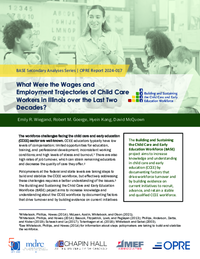What Were the Wages and Employment Trajectories of Child Care Workers in Illinois over the Last Two Decades?

The workforce challenges facing the child care and early education (CCEE) sector are well known. CCEE educators typically have low levels of compensation; limited opportunities for education, training, and professional development; inconsistent working conditions; and high levels of stress and burnout. There are also high rates of job turnover, which can strain remaining educators and decrease the quality of care they offer.
Policymakers at the federal and state levels are taking steps to build and stabilize the CCEE workforce, but effectively addressing these challenges requires a better understanding of the issues. The Building and Sustaining the Child Care and Early Education Workforce (BASE) project aims to increase knowledge and understanding about the CCEE workforce by documenting factors that drive turnover and by building evidence on current initiatives to recruit, advance, and retain a stable and qualified CCEE workforce. The project began with a literature review and a scan of existing strategies, which summarized the knowledge base to date but also identified key gaps in the research. The project also included a scan of existing data to identify available data sources that might be used to address these knowledge gaps.
A key gap identified by the BASE project is the lack of data sources that capture longitudinal data on the same educators over time, which is critical for answering questions about how teachers enter, stay in, and exit the field. This brief uses one promising source of longitudinal workforce data to address these questions of workforce dynamics—quarterly wage data reported to the Illinois Department of Employment Security to support the Unemployment Insurance (UI) program (UI wage data). Specifically, this brief looks at which industries new CCEE workers come from, how long they stay in the field, and which industries they enter after leaving the field. The brief also examines the employment duration of first child care jobs and first spells of employment in the CCEE industry.
Understanding the CCEE workforce experience and employment pathways can inform the design of strategies to recruit new workers and retain existing workers. For example, policymakers considering efforts to improve wages or retention in the industry can use these metrics to inform the scale of interventions and how those interventions could be targeted. The ability to characterize workers’ pathways across industries and to compare wages for those individuals over time are particular strengths of the UI wage data. By contextualizing the workforce within the broader labor market, data on wages and movement across industries highlight the competition CCEE employers face in retaining workers for challenging jobs with low pay.
Research Questions and Key Findings
Research question 1: What wages are child care workers earning according to Illinois UI wage data? How do these reported amounts compare to other estimates of wages in this workforce?
Key Findings: After adjusting for inflation, child care workers in Illinois saw a 12 percent increase in wages between 2006 and 2019, followed by a 9 percent increase between 2019 and 2021.
Research question 2: Which industries do individuals work in before they start in child care? What do they earn, and how do these wages compare to their initial child care wages?
Key Findings: In 2019, new Illinois child care workers had prior employment in industries such as Food Services, Education, and Administrative Services. Wages earned in past employment were similar to or lower than starting child care wages.
Research question 3: How long do new workers stay in the child care industry after they start? How do wages change over time for workers who are continuously employed in child care?
Key Findings: More than half of Illinois child care workers left the industry after less than two years of employment in child care. For workers who remained employed in child care, inflation-adjusted wages increased over time at the median rate of 26 percent over 5 years and 50 percent over 10 years.
- Research question 4: What industries do former child care workers transition to after leaving the child care industry? How do their wages in these industries compare to their wages before leaving child care?
Key Findings: Nearly one out of every three workers who moved from child care to another industry in Illinois took a job in education. Child care workers who left child care for another industry generally earned higher wages in their first full quarter of employment in the other industry.
Document Details
Wiegand, Emily R., Robert M. Goerge, Hyein Kang, David McQuown (2024). What Were the Wages and Employment Trajectories of Child Care Workers in Illinois over the Last Two Decades? OPRE Report 2024-017. Washington, DC: Office of Planning, Research, and Evaluation, Administration for Children and Families, U.S. Department of Health and Human Services.






